Abstract
Winter oilseed rape (Brassica napus) is one of the most cultivated oilseeds in the Czech Republic and belongs among major pollen allergens. Pollen allergies have an extensive clinical impact worldwide, and as well as in the Czech Republic. In this paper, meteorological variables such as mean air temperature, maximum and minimum air temperature, precipitation total and number of rainy days in the period 1991–2012 were studied using the PhenoClim phenological model to find the best predictor of the beginning of flowering of the Brassica napus in the Czech Republic. In addition, temporal and spatial evaluations of the beginning of flowering of the Brassica napus were examined at individual stations in different climatic zones within the same period. In total, three phenological stations at altitudes from 270 m asl to 533 m asl located in warm (W2), medium warm (MW7) or cold (C7) climatic zones were used for detailed evaluation. Based on the observation results at selected stations, the beginning of flowering of the Brassica napus advanced progressively in timing (nearly −15 days) in the 1991–2012 period. The base temperature and temperature sums were calculated for the beginning of flowering of the winter oilseed rape using the PhenoClim computer tool. As the most accurate predictor for the beginning of flowering of the Brassica napus, the mean air temperature was determined. The optimal start day for calculation was 30th January, the threshold (base temperature) was 6.0 °C and the temperature sum was 157.0 °C. The RMSE value was 4.77 and the MBE value was −3.00. The simulated data had a good correlation with the real observed data (the correlation coefficients were within the range from 0.56 to 0.76), and the PhenoClim model results indicate using them in the forecast modeling of the beginning of flowering of the Brassica napus in the Czech Republic.
1. Introduction
Winter oilseed rape (Brassica napus) is the most cultivated oilseed in the Czech Republic. The blossoming plants have a typical odour, which they cause by releasing a mixture of organic substances [1]. It is of a great importance in terms of food, industrial use (biofuels) and trade in commodities. Knowledge of the biological properties and requirements of winter oilseed rape for habitats is a basic prerequisite for its successful cultivation. Moreover, Brassica napus or edible oilseed rape is the third most important oilseed produced globally with annual production increasing 2–4-fold in many of the major producing countries in the last 20 years [2]. Unfortunately, Brassica napus is one of the major pollen allergens. Pollen grains are covered with sticky lipoid substances and the pollen grains are glued together; this increases their weight and limits their possibility to remain longer in the air. The blossoming plants have a typical odour, which they cause by releasing a mixture of organic substances [1]. Pollen allergies have an extensive clinical impact worldwide, and as well as in the Czech Republic. The allergenic content of the atmosphere varies according to climate, geography and vegetation [3]. Timely information on the beginning of the flowering of significant pollen allergens is very important for the entire population, and in the case of Brassica napus the information is important as well as for farmers for timely applications of protective plant sprays. The authors of [4] evaluated climatic variables and their effect on Brassica napus development and yield. Some authors, e.g., [5], have stated that frost at the beginning of flowering increases branching, and the flowering lasts longer, resulting in an increased number of poorly filled pods formed on the lower branches. Furthermore, if the post-flowering period is water limited, the yield will be low, as canopy transpiration cannot be met [6].
Phenology deals with the timing of recurring biological events in the plant and animal world [7]; it is an important tool in pollen season prediction, as well as in Brassica napus flowering. Brassica napus blooms in spring at the peak of a pollen season. The beginning of Brassica napus flowering has become variable due to climate change.
Timely information on the beginning of flowering of the Brassica napus based on modeling is missing in the Czech Republic, and it is also important to know of shifts in the timing of flowering of the Brassica napus due to farming practices.
Many authors have noted (e.g., [8,9]) that various phenological models have been developed to simulate the relationships between plant phenology and meteorological factors. The use of degree days for calculating the temperature-dependent development of plants is widely accepted as a basis for building phenology and population dynamic models. The authors of [10,11,12,13] developed phenological models for natural vegetation and they found that it is important to calibrate these models with ground observations or remote sensing data. Further, [14] mentioned, in regard to the simplest form of models, the simple thermal time (STT) model, which has three parameters: (1) the day of the year after which temperature sums are calculated; (2) the base temperature threshold above which temperature sums are calculated; and (3) the critical thermal sum threshold, which represents the accumulated temperature sum at which a given phenological phase is triggered. Phenological observations might be useful in determining areas with increasing pollen release and, moreover, could be used as input data for atmospheric dispersion models.
Our hypothesis was as follows: (1) the shift of the beginning of flowering of the Brassica napus is similar within the entire area of the Czech Republic (north-south and east-west gradient) and (2) the modeled data (results of the PhenoClim model) will be similar to the real observed data. In addition, we wanted to find out which meteorological element is most important for winter oilseed rape flowering.
The main goals of this paper were as follows: (1) to analyze the temporal and spatial evaluation of the beginning of flowering of the Brassica napus in the Czech Republic in the main 1991–2000, 2001–2010 and 1991–2010 periods; (2) to evaluate the trend in the beginning of flowering of the Brassica napus in the 1991–2012 period at individual stations located in different climatic zones of the Czech Republic; (3) to calculate temperature sums (Ts) and base temperatures (Tbase) for the prediction of the beginning of flowering of the Brassica napus based on the simple thermal time (STT) model using the PhenoClim model, and (4) to compare modeled PhenoClim results with real observed data.
2. Material and Methods
The Czech Hydrometeorological Institute (CHMI) has been managing a phenological network of different plant species since the middle of the 20th century [1]. Voluntary phenological observers record the onset of phenological stages according to prescribed methodology [1]. The Brassica napus was a part of the CHMI phenological field crop network until 2012 (from 1st January 2013, the entire phenological network of field crops was canceled). The regular phenological observations were performed on the same experimental area at least twice a week during the growing period. A description of the beginning of flowering of the winter oilseed rape is as follows: the first flowers were opened on the 10% of the experimental area (see Figure 1).
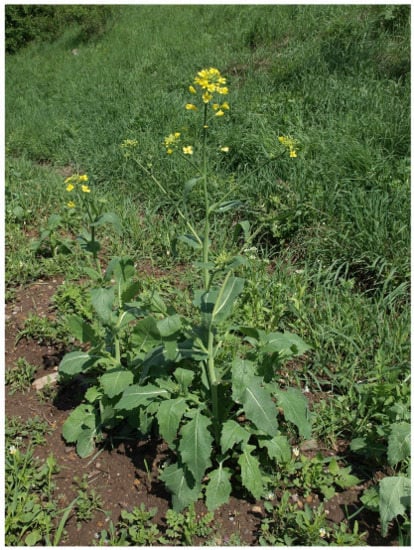
Figure 1.
Beginning of flowering of the winter oilseed rape (Brassica napus).
There are nine phenological phases of winter oilseed rape, according to the CHMI methodology. In this paper, we focused on the beginning of flowering (BBCH scale 60 according to [15]), which is the phenological phase connected with pollen release and yield formation. The phenological dates were reported on the day of year (DoY). Phenological data were exported from the PHENODATA database (the CHMI official phenological database). As analytical tools, regression analysis and a geographic information system (GIS) were used. The processed period was 1991–2012. The phenological trends of the beginning of flowering were studied using a regression equation (mean temporal change in days per year). The maps were created in the framework of the geographic information system ArcGIS version 10.4.1, and the Clidata-DEM method was used (this method is based on local linear regression between the measured or calculated value and the digital relief model with dependence on altitude (e.g., [16]). The mean date of the beginning of flowering was used as the input data. In total, data from 60 stations with means above sea level ranging from 155 m (Doksany) to 725 m (Nedvězí) were used. Subsequently, grid calculation between the grid of PhenoClim model data and grid of real observed data was performed. Simultaneously, the detailed study was made at three phenological stations located at different elevations and different climatic zones in the Czech Republic (Kujavy, Chrastava and Senožaty—see Figure 2). The climate conditions of phenological stations were characterized by climagrams (Figure 3), and geographical characteristics of climatological and phenological stations, including an inclusion of the station in the climate area according to Quitt’s classification, are mentioned in Table 1.
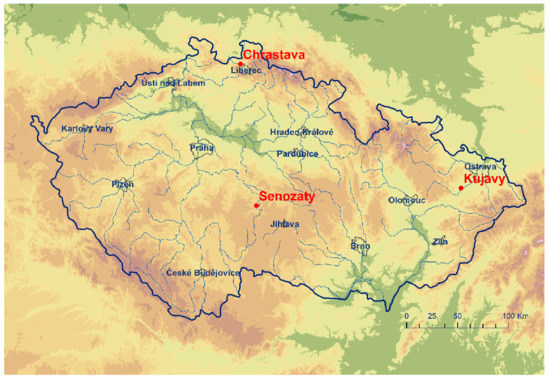
Figure 2.
Map of selected CHMI stations.
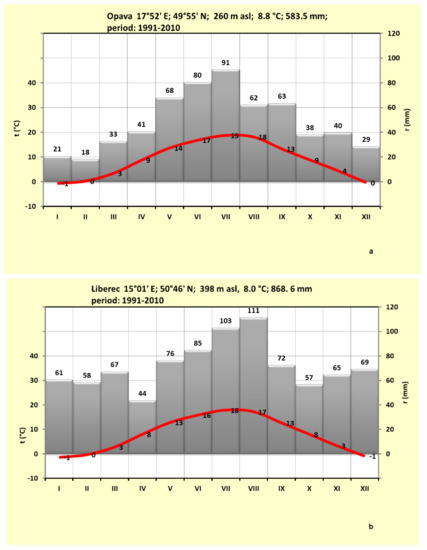
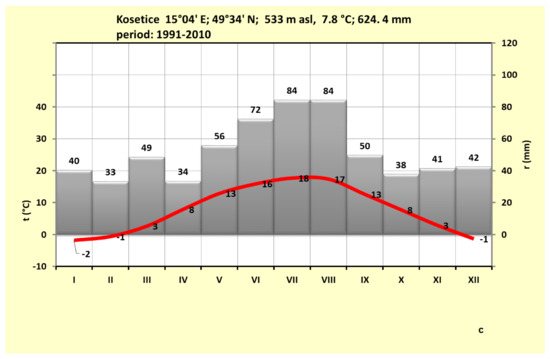
Figure 3.
Climagrams of selected CHMI stations—Opava (a), Liberec (b) and Kosetice (c).

Table 1.
Characteristics of phenological (P) and climatological (C) stations including Quitt‘s classification [17].
The PhenoClim model ([18]) was used to obtain model data of the Brassica napus beginning of flowering (BBCH 60). The PhenoClim model calculates with two variables: base temperature (Tbase) and temperature sum (Ts). Tbase is defined as a biological threshold where ongoing metabolic processes take place in aboveground plant parts. Ts is described as the sum of positive differences between diurnal mean temperatures and a given Tbase [19]. In daily steps, meteorological input data for the 1991–2012 period were prepared for the PhenoClim model. These subsequent meteorological parameters were required for complex analysis: minimum and maximum air temperature (°C), amount of precipitation (mm), water vapor pressure (hPa), global solar radiation (MJ·m−2) and wind speed (m·s−1). So-called “technical series” of the selected meteorological elements from the CHMI meteorological stations were used, and the software packages AnClim, LoadData and ProClimDB [20] for the “technical series” data were applied. The phenological values of the beginning of flowering were prepared in DoY for the same period such as meteorological elements (1991–2012). All input data (meteorological and phenological) were arranged in columns (it is a prescribed format of the PhenoClim model). The data (both phenological and meteorological) were divided into two parts because the model worked in two steps. The first data part was used for the calibration (1991–2000), and the second part of the data was used for the validation (2001–2012). The PhenoClim model allows the selection of the best combination of Ts and Tbase for each species (phenophase onset) based on the calibration dataset. The best combination was carried out the set of statistical variables: root mean square error (RMSE), coefficient of determination (R2) and mean bias error (MBE). The MBE shows the difference between the actual and measured values.
3. Results
The results of the average onset of the beginning of flowering of the Brassica napus in three periods (1991–2000, 2001–2010 and 1991–2010) are presented in the following maps (Figure 4a). The time range of the beginning of flowering of the Brassica napus was about two weeks in the Czech Republic—mean limit values in the maps were 30th April (DoY = 120) and 15th May (DoY = 135). In the second decade (2001–2010), the beginning of flowering started before 30th April in more than one third of the Czech Republic (CR) and later than 15th May only in 5% of the CR. A significant difference between the two maps can be seen at a glance. Figure 4b shows results of the beginning of flowering of the Brassica napus based on the PhenoClim model data (the best predictor, and Figure 4c presents difference between the PhenoClim model data and the real observed data (results are based on the grid calculation). The difference was in the range from −4 days to +2 days. In 1991–2000 period, a difference from −2 days to +2 days prevailed, and in 2001–2010 and 1991–2010 periods a difference between zero and +2 days prevailed.
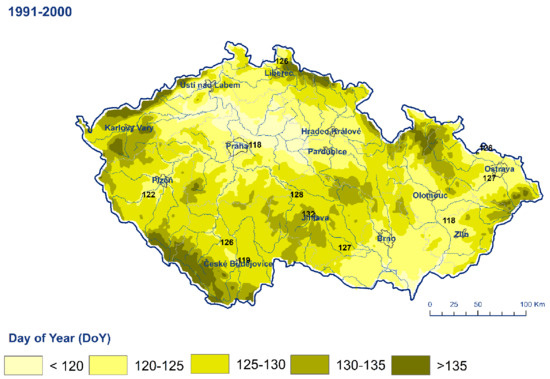
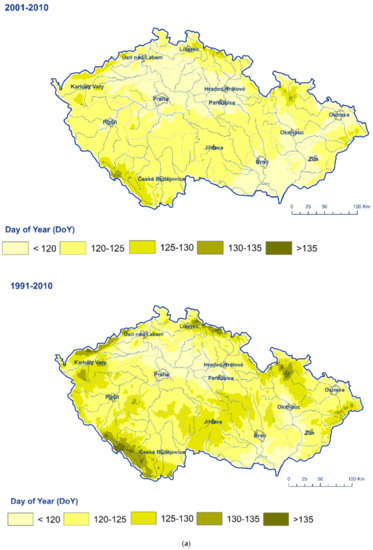
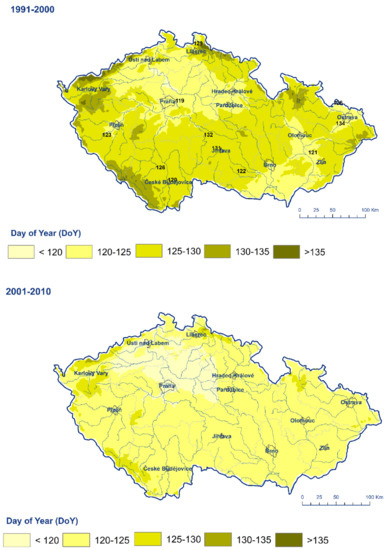
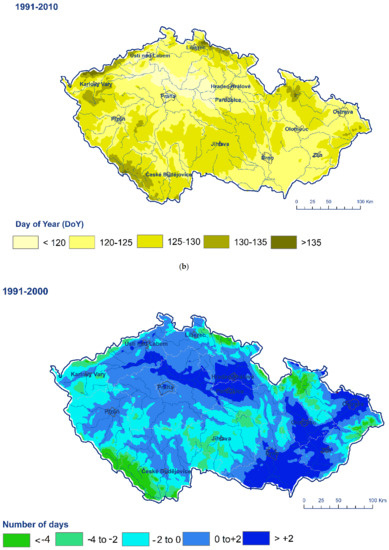
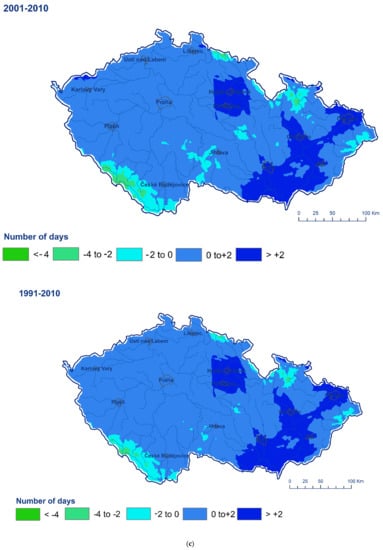
Figure 4.
(a). Beginning of flowering of the Brassica napus in the Czech Republic within the 1991–2000, 2001–2010 and 1991–2010 periods. Results are based on the real observed data. (b). Beginning of flowering of the Brassica napus in the Czech Republic within the 1991–2000, 2001–2010 and 1991–2010 periods. Results are based on the PhenoClim model data (on the best predictor) 2. (c). Number of days—difference between grid of the PhenoClim model data and grid of the real observed data of the beginning of flowering of the Brassica napus in the Czech Republic within the 1991–2000, 2001–2010 and 1991–2010 periods.
Table 2 presents linear trends of the beginning of flowering of the Brassica napus in the 1991–2012 period. There was a shift to an earlier onset of the beginning of flowering at all selected stations and the timing advanced to an earlier time by 15.6 days during the entire period at the Kujavy station (260 m asl, W2), which had the highest coefficient of determination (0.45). The southernmost station, Senožaty station (533 m asl, MW7), had a shift in the beginning of flowering of 14.9 days, and the Chrastava station (310 m asl, C7) advanced more than 10 days.

Table 2.
Linear trends for the beginning of flowering of the Brassica napus at individual phenological stations during the 1991–2012 period (Per) including coefficients of determination R2. Stations are listed by altitude.
The results showed that although the stations are located in different climatic conditions (Figure 3) and altitudes (Table 1), the differences in phenophase onset shifts were similar, and the maximum was about 5 days.
Table 3 represents a statistical summary of the beginning of flowering of the Brassica napus PhenoClim STT model validation. The mean air temperature was determined to be the best predictor for the beginning of the Brassica napus flowering, as the combination of RMSE and R2 showed the best values. The best start day for calculation was 30th January. The threshold (Tbase) was 6.0 °C, and temperature sums (Ts) was 157.0 °C. Values of RMSE and MBE were 4.78 and −3.00. Other meteorological variables such as maximum air temperature (TMA), minimum air temperature (TMI), precipitation total (SRA) and number of rainy days (NRD) were also tested by the PhenoClim model. All these variables had RMSE values higher than by mean air temperature (5.35 (TMA); 6.42 (TMI); 10.58 (SRA) and 47.35 (NRD) and R2 was lower (0.39 (TMA); 0.41 (TMI); 0.29 (SRA) and 0.22 (NRD).

Table 3.
Statistical summary for the beginning of flowering (BBCH 60) of Brassica napus validation according to the PhenoClim STT model.
The following scatter plots (Figure 5) illustrate the relationship between the observed and modeled data of the beginning of flowering of the Brassica napus, including coefficients of determination and regression equations. Values of the coefficients of determination oscillated between 0.5551 (Kujavy station) and 0.7621 (Chrastava station). The simulated data showed a good correlation with the real observed data.
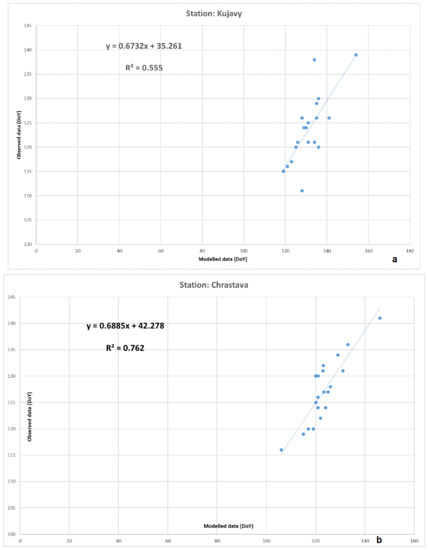
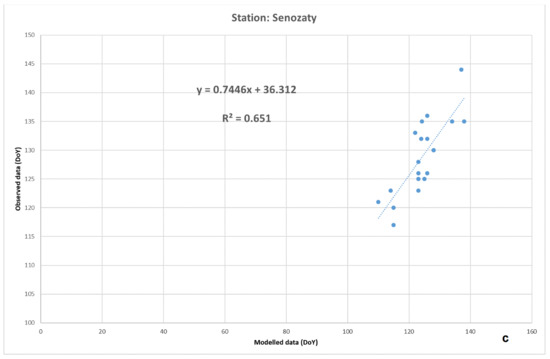
Figure 5.
Scatter plots of real observed data and modeled data of the beginning of flowering of the Brassica napus based on the PhenoClim model (STT). Stations are listed by altitude—Kujavy (a), Chrastava (b) and Senozaty (c).
4. Discussion
The analysis showed that the beginning of Brassica napus changed progressively over time during the entire 1991–2010 period, and the onset of phenophase comes about 14 days on average earlier (from −10.7 to −15.6 days). Furthermore, there were no significant differences between particular regions, especially between the northern and southern parts and between the eastern and western parts of the Czech Republic. Many authors confirmed in their papers the fact that the timing of phenophases is changing, e.g., [21,22,23,24,25,26], and the shift of phenological stages to an earlier time (mainly spring phenological phases) is widely accepted. The results of [27] provided evidence for a rapid, adaptive evolutionary shift in flowering phenology of B. rapa after a climatic fluctuation. In our analysis, we focused on in-situ data processing using GIS but according to [28] a novel methodology is proposed to robustly map oil seed rape flowering phenology from time series generated from the Copernicus Sentinel-1 and Sentinel-2 sensors. However, it is important to note that in-situ data should be used for calibration. In addition, [29], in their paper, showed that the additional in-situ phenology observations at 70 Deutscher Wetterdients (DWD) stations confirmed the spatial and temporal consistency between Sentinel-1 and Sentinel-2 signatures and flowering phenology across northern and southern regions. Furthermore, peak flowering of Brassica napus was detected with an accuracy of 1 to 4 days when combining Sentinel-1 & -2.
Flowering of the Brassica napus is important from the allergological point of view, and as well as it is a critical period for yield formation, e.g., [4,30,31].
To estimate the possible impacts of temperature rise on plant development, a thermal time model (PhenoClim) was used and showed that the best predictor for the onset of flowering of the Brassica napus was the mean air temperature (start day 30th January, threshold 6.0 °C and Tsums = 157.0 °C). The best fit of the model was defined by the statistical variables RMSE, MBE and R2 (RMSE = 4.78; MBE = −3.00 and R2 = 0.55).
The simulated data via the PhenoClim model had a good correlation with the real observed data (R2 were within the range from 0.56 to 0.65). The difference between the grid of the PhenoClim model data and grid of the real observed data was from −4 days to +2 days. The reason was probably due to a good quality of in-situ observed phenological data. The phenological data were observed by the same observer at each station during the entire 1991–2012 period and according to the same prescribed methodology. The author of [32] used, in his winter oilseed rape study, an empirical BRASNAP-PH model and the mean deviations between simulated and experimental dates were 3.0 d for onset of flowering. This model appeared to be reliable for predicting the onset and end of flowering and the maturity of winter oilseed rape in relation to temperature and photoperiod.
Other authors have also dealt with Brassica napus modelling, e.g., [33] created weather model for the winter oilseed rape cultivation. They found as high-risk meteorological factors dryness or wetness during sowing, warm autumn, cold winter, high number of days with strong frost, low number of days with snow-cover and high number of days with precipitation during flowering. Additionally, [34] studied yield instability of winter oilseed rape modulated by early winter temperature and proposed that understanding the mechanism by which early winter chilling affects winter oilseed rape yield will enable the breeding of varieties with a more stable and resilient yield in Western Europe as climatic variation increases.
Ref. [35] investigated genotypes of Brassica napus to determinate which traits of crop establishment are related to abiotic stress tolerance. Their hydrotime model parameters were determined in a laboratory germination test, where seedling emergence and growth were evaluated in pot experiments under control, drought, salinity, deep sowing and low and high temperatures. Their results showed wide variations among genotypes for germination characteristics and hydrotime parameters under different environmental conditions. Focused on temperature (temperature is the limiting factor for germination and Brassica napus seedling growth), according to [36] the base, optimum, and ceiling temperatures ranged from 0 to 5, 21–35, and 41–46 °C for germination rate of Brassica napus. Additionally, [36] stated that it is important to develop cultivars with chilling or heat tolerance, as these allow cultivars to tolerate the cold or heat stresses during early Brassica napus growth, allowing for better crop establishment. Many other authors dealt with germination response of Brassica napus to temperature using different models, e.g., [37], the majority of these models assume a Normal distribution for both sub-optimal thermal time and maximum temperature to describe the variation in time to germination. Following this, [38] used a range of mathematical models versus temperature and found out that repeated probit analysis method (a modified and improved method) was the most suitable for estimating the rapeseed base temperature due to the lowest RRSME (respective root mean square error).
Further, Ref. [39] applied generalized logistic functions (Richards model with time shift) to predict the emergence of winter rapeseed (Brassica napus L.) after its seed treatment with plant extracts from Taraxacum officinale roots under controlled environment conditions. The proposed mathematical description based on generalized logistic functions showed extraordinary fit (r = 0.999) to the experimental data, which makes it highly useful in predictive control of rapeseed emergence. Other authors researched genotype by environment interaction for oil content in Brassica napus (increasing seed oil content is one of the primary objectives in rapeseed breeding) using additive main affects and multiplicative interaction model (AMMI), e.g., [40].
According to [41], the most widely applied pollen model is Prentice’s model, which uses a modified form of Sutton’s equation for atmospheric diffusion to predict pollen-source areas from size of the depositional basin and a set of depositional parameters (deposition velocity of the pollen grains and mean wind speed) and atmospheric parameters (turbulence parameter, vertical diffusion coefficient). Additionally, [42] stated that pollen concentrations frequently exceed the threshold of the appearance of allergic symptoms, except during rainfall.
Understanding the spatiotemporal patterns of changes in pollen season timing and levels is thus important in assessing climate impacts on aerobiology and allergies caused by allergic airborne pollen [43], such as Brassica napus. Many authors have stated (e.g., [44]) that climate change affects allergic disease and that new impacts of allergens on human health are a consequence of climate change. Moreover, climate change affects farming, and it is necessary to prepare farmers for changes in agrotechnical practices.
5. Conclusions
In this paper was evaluated the prediction of the beginning of flowering of the winter oilseed rape (Brassica napus) based on the PhenoClim phenological model using long-term phenological observations (1991–2012) in the Czech Republic. Temporal and spatial evaluations of the beginning of flowering of Brassica napus were examined at individual stations in different climatic zones in the Czech Republic within the same period. The beginning of flowering of Brassica napus advanced progressively in timing (nearly −15 days) and there was no significant difference between southern and northern parts and eastern and western parts of the Czech Republic. The base temperature and temperature sums were calculated for the beginning of flowering of the Brassica napus using the PhenoClim computer tool. Mean air temperature was determined to be the most accurate predictor for the beginning of flowering of the Brassica napus. Other meteorological variables had weaker statistical results. The optimal start day for calculation was January 30th, the threshold (base temperature) was 6.0 °C and the temperature sum was 157.0 °C. The simulated data had a good correlation with the real observed data (the correlation coefficients were within the range from 0.56 to 0.76), and the difference between the gridded data (PhenoClim model data and real observed data) was from −4 days to +2 days. The PhenoClim model results indicate using them in the forecast modeling of the beginning of flowering of Brassica napus in the Czech Republic. Our hypotheses were confirmed.
A forecast model for the beginning of flowering of the agricultural crops belonging among pollen allergens is missing in the Czech Republic. Pollen allergy-sensitive persons have to be prepared for the Brassica napus pollen release at the peak of the pollen season in spring. Moreover, results could be used in practical farming (e.g., in a plant protection product applications to increase yield, etc.).
In summary, this study demonstrated a significant shift of the beginning of flowering of the Brassica napus and, subsequently, this study revealed results for forecast modeling based on the PhenoClim model using CHMI phenological and meteorological data. In addition, other agricultural crops (e.g., maize or cereals) belong among significant pollen allergens. Thus, it is necessary to continue climate change research on other agriculture plant species to develop predictions for these species, and not only for pollen forecast but also for yield prediction and new agrotechnical practices.
Author Contributions
Conceptualization, L.H. and Z.Ž.; methodology, L.H.; software, M.M. and L.B.; validation, L.H., M.M. and Z.Ž.; formal analysis, V.O., L.B. and P.D.; investigation, L.H. and V.O.; resources, L.H.; data curation, P.D.; writing—original draft preparation, L.H., M.M. and Z.Ž.; writing—review and editing, L.H., M.M. and Z.Ž.; visualization, V.O.; supervision, Z.Ž.; project administration, M.M and Z.Ž.; funding acquisition, M.M. and Z.Ž. All authors have read and agreed to the published version of the manuscript.
Funding
This research was funded by Ministry of Education, Youth and Sports of the Czech Republic the project SustES—Adaptation Strategies for the Sustainability of Ecosystem Services and Food Security in Adverse Natural Conditions (CZ.02.1.01/0.0/0.0/16 019/0000797), by the Technology Agency of the Czech Republic Project No. SS02030018 and by the Ministry of Agriculture of the Czech Republic—National Agency for Agricultural Research Project No. QK1910338.
Data Availability Statement
Not applicable.
Conflicts of Interest
The authors declare no conflict of interest.
References
- Hájková, L.; Voženílek, V.; Tolasz, R.; Kohut, M.; Možný, M.; Nekovář, J.; Novák, M.; Reitschläger, J.D.; Richterová, D.; Stříž, M.; et al. Atlas of the Phenological Conditions in Czechia; CHMI Prague-UP Olomouc: Prague, Czech Republic, 2012; p. 312. [Google Scholar]
- Kirkegaard, J.A.; Lilley, J.M.; Morrison, M.J. Drivers of trends in Australian canola productivity and future prospects. Crops Pasture Sci. 2016, 67, i–ix. [Google Scholar] [CrossRef] [Green Version]
- D’Amato, G.; Cecchi, L.; Bonini, S.; Nunes, C.; Annesi-Maesano, I.; Behrendt, H.; Liccardi, G.; Popov, T.; van Cauwenberge, P. Allergenic pollen and pollen allergy in Europe. Allergy 2007, 62, 976–990. [Google Scholar] [CrossRef] [PubMed]
- Marjanovič-Jeromela, A.; Terzič, S.; Jankulovska, M.; Zorič, M.; Kondič-Špika, A.; Jockovič, M.; Hristov, N.; Crnobarac, J.; Nagl, N. Dissection of Year Related Climatic Variables and Their Effect on Winter Rapeseed (Brassica Napus L.) Development and Yield. Agronomy 2019, 9, 517. [Google Scholar] [CrossRef] [Green Version]
- Balodis, O.; Gaile, Z. Sowing date and rate effect on winter oilseed rape (Brassica napus L.) yield components formation. Proc. Latv. Acad. Sci. Sect. B 2016, 70, 384–392. [Google Scholar] [CrossRef] [Green Version]
- Weymann, W.; Bőttcher, U.; Sieling, K.; Kage, H. Effects of weather conditions during different growth phases on yield formation of winter oilseed rape. Field Crops Res. 2015, 173, 41–48. [Google Scholar] [CrossRef]
- About the Pan European Phenology Project PEP725. Available online: www.pep725.eu (accessed on 1 November 2021).
- Chuine, I.; de Cortazar-Atauri, I.G.; Kramer, K.; Hanninen, H. Plant development models. In Phenology: An Integrative Environmental Science; Schwartz, M.D., Ed.; Springer: Dordrecht, The Netherlands, 2013; pp. 275–293. [Google Scholar]
- Vitasse, Y.; Francois, C.; Delpierre, N.; Dufrene, E.; Kremer, A.; Chuine, I.; Delzon, S. Assesing the effects of climate change on the phenology of European temperate trees. Agric. For. Meteorol. 2011, 151, 969–980. [Google Scholar] [CrossRef]
- Roltsch, W.J.; Zalom, F.G.; Strawn, A.J.; Strand, J.F.; Pitcairn, M.J. Evaluation of several degree-day estimation methods in California climates. Int. J. Biometeorol. 1999, 42, 169–176. [Google Scholar] [CrossRef]
- Botta, A.; Viovy, N.; Ciais, P.; Friedlingstein, P.; Monfray, P. A global prognostic scheme of leaf onset using satellite data. Glob. Chang. Biol. 2000, 6, 709–725. [Google Scholar] [CrossRef]
- Jolly, W.M.; Nemani, R.; Running, S.W. A generalized, bioclimatic index to predict foliar phenology in response to climate. Glob. Chang. Biol. 2005, 11, 619–632. [Google Scholar] [CrossRef]
- Templ, B.; Fleck, S.; Templ, M. Change of plant phenophases explained by survival modeling. Int. J. Biometeorol. 2017, 61, 881–889. [Google Scholar] [CrossRef]
- Bennie, J.; Kubin, E.; Wiltshire, A.; Huntley, B.; Baxter, R. Predicting spatial and temporal patterns of bud-burst and spring frost risk in north-west Europe: The implications of local adaptation to climate. Glob. Chang. Biol. 2010, 16, 1503–1514. [Google Scholar] [CrossRef]
- Meier, U. BBCH-Monograph: Growth Stages of Mono- and Dicotyledonous Plants, 2nd ed.; Technical Report; Federal Biological Research Centre for Agriculture and Forestry: Bonn, Germany, 2001. [Google Scholar]
- Tolasz, R.; Míková, T.; Valeriánová, A.; Voženílek, V. Climate Atlas of Czechia, 1st ed.; CHMI: Prague, Czech Republic, 2007; p. 255. ISBN 978-80-86690-26-1. [Google Scholar]
- Květoň, V.; Voženílek, V. Climatic Regions of Czechia–Quitt’s Classification during Years 1961–2000; Palackého University: Olomouc, Czech Republic, 2011; p. 20. ISBN 978-80-244-2813-0. [Google Scholar]
- Černá, H.; Bartošová, L.; Trnka, M.; Bauer, Z.; Štěpánek, P.; Možný, M.; Dubrovský, M.; Žalud, Z. The analysis of long-term phenological data of apricot tree (Prunus armeniaca L.) in southern Moravia during 1927–2009. Acta Univ. Agric. Et Silvic. Mendel. Brun. 2012, 60, 9–18. [Google Scholar] [CrossRef]
- Solantie, R. Daytime temperature sum—A new thermal variable describing growing season characteristics and explaining evapotranspiration. Boreal Environ. Res. 2004, 9, 319–333. [Google Scholar]
- Zahradníček, P.; Rasol, D.; Cindric, K.; Štěpánek, P. Homogenization of monthly precipitation time series in Croatia. Int. J. Climatol. 2014, 34, 3671–3682. [Google Scholar] [CrossRef]
- Ahas, R.; Aasa, A.; Menzel, A.; Fedotova, V.G.; Scheifinger, H. Changes in European spring phenology. Int. J. Climatol. 2002, 22, 1727–1738. [Google Scholar] [CrossRef]
- Chmielewski, F.M.; Műller, A.; Bruns, E. Climate changes and trends in phenology of fruit trees and field crops in Germany, 1961–2000. Agric. For. Meteorol. 2004, 121, 69–78. [Google Scholar] [CrossRef]
- Menzel, A.; Sparks, T.H.; Estrella, N.; Koch, E.; Aasa, A.; Ahas, R.; Alm-Kübler, K.; Bissolli, P.; Braslavská, O.G.; Briede, A.; et al. European phenological response to climate change matches the warming patterns. Glob. Chang. Biol. 2006, 12, 1969–1976. [Google Scholar] [CrossRef]
- Poikolainen, J.; Tolvanen, A.; Karhu, J.; Kubin, E. Seventeen-year trends in spring and autumn phenophases of Betula pubescens in a boreal environment. Int. J. Biometeorol. 2016, 60, 1227–1236. [Google Scholar] [CrossRef]
- Hájková, L.; Kožnarová, V.; Možný, M.; Bartošová, L. Influence of climate change on flowering season of birch in the Czech Republic. Int. J. Biometeorol. 2020, 64, 791–801. [Google Scholar] [CrossRef]
- Franks, S.J.; Sim, S.; Weis, A.E. Rapid evolution of flowering time by an annual plant in response to a climate fluctuation. Proc. Natl. Acad. Sci. USA 2007, 104, 1278–1282. [Google Scholar] [CrossRef] [Green Version]
- Branzi, G.P.; Zanotti, A.L. Estimate and mapping of the activity of airborne pollen sources. Aerobiologia 1992, 8, 69–74. [Google Scholar] [CrossRef]
- Andrimont, R.; Taymans, M.; Lemoine, G.; Ceglar, A.; Yordanov, M.; Velde, M. Detecting flowering phenology in oil seed rape parcels with Sentinel-1 and -2 time series. Remote Sens. Environ. 2020, 239, 111660. [Google Scholar] [CrossRef]
- Kirkegaard, J.A.; Lilley, J.M.; Brill, R.D.; Ware, A.H.; Walela, C.K. The critical period for yield and quality determination in canola (Brassica napus L.). Field Crop. Res. 2018, 222, 180–188. [Google Scholar] [CrossRef]
- Schiessl, S.; Iniguez-Luy, F.; Qian, W.; Snowdon, R.J. Diverse regulatory factors associate with flowering time and yield responses in winter-type Brassica napus. BMC Genom. 2015, 16, 737. [Google Scholar] [CrossRef] [Green Version]
- Habekotte, B. A model of the phenological development of winter oilseed rape (Brassica napus L.). Field Crops Res. 1997, 54, 127–136. [Google Scholar] [CrossRef]
- Klabzuba, J.; Kožnarová, V. Usage possibilities of standard climatic characteristics for agrometeorological purposes. Folia Oecologica 2008, 35, 60–65. [Google Scholar]
- Brown, J.K.M.; Beeby, R.; Penfield, S. Yield instability of winter oilseed rape modulated by early winter temperature. Sci. Rep. 2019, 9, 6953. [Google Scholar] [CrossRef] [Green Version]
- Soltani, E.; Adeli, R.; Akbari, G.A.; Ramshini, H. Application of hydrotime model to predict early vigour of rapeseed (Brassica napus L.) under abiotic stresses. Acta Physiol. Plant. 2017, 39, 252. [Google Scholar] [CrossRef]
- Farzaneh, S.; Soltani, E.; Zeinali, E.; Ghaderi-Far, F. Screening oil seed rape germination for thermotolerance using a laboratory-based mathod. Seed Tech. 2014, 36, 15–27. [Google Scholar]
- Derakhshan, A.; Bakhshandeh, A.; Siadat, S.A.; Moradi-Telavat, M.R.; Andarzian, S.B. Quantifying the germination response of spring canola (Brassica napus L.) to temperature. Ind. Crop. Prod. 2018, 122, 195–201. [Google Scholar] [CrossRef]
- Luo, T.; Xian, M.; Khan, M.N.; Hu, L.; Xu, Z. Estimation of base temperatur efor germination of rapeseed (Brassica napus) using different models. Int. J. Agric. Biol. 2018, 20, 524–530. [Google Scholar] [CrossRef]
- Szparaga, A.; Kocira, S. Generalized logistic functions in modelling emergence of Brassica napus L. PLoS ONE 2018, 13, e0201980. [Google Scholar] [CrossRef] [PubMed]
- Nowosad, K.; Liersch, A.; Poplawska, W.; Bocianowski, J. Genotype by environment interaction for oil content in winter oilseed rape (Brassica napus L.) using additive main effects and multiplicative interaction model. Indian J. Genet. 2017, 77, 293–297. [Google Scholar] [CrossRef] [Green Version]
- Jackson, S.T.; Lyford, M.E. Pollen dispersal models in Quaternary plant ecology: Assumptions, parameters, and prescriptions. Bot. Rev. 1999, 65, 39–75. [Google Scholar] [CrossRef]
- Clot, B. Airborne birch pollen in Neuchâtel (Switzerland): Onset, peak and daily patterns. Aerobiologia 2001, 17, 25–29. [Google Scholar] [CrossRef]
- Zhang, Y.; Bielory, L.; Georgopoulos, P.G. Climate change effect on Betula (birch) and Quercus (oak) pollen seasons in the United States. Int. J. Biometeorol. 2014, 58, 909. [Google Scholar] [CrossRef] [Green Version]
- Beggs, P.J. (Ed.) Impacts of Climate Change on Allergens and Allergic Diseases; Cambridge University Press: Cambridge, UK, 2016. [Google Scholar]
- Ziska, L.H.; Makra, L.; Harry, S.K.; Bruffaerts, N.; Hendrickx, M.; Coates, F.; Saarto, A.; Thibaudon, M.; Oliver, G.; Damialis, A.; et al. Temperature-related changes in airborne allergic pollen abundance and seasonality across the northern hemisphere: A retrospective data analysis. Lancet Planet. Health 2019, 3, e124–e131. [Google Scholar] [CrossRef] [Green Version]
Publisher’s Note: MDPI stays neutral with regard to jurisdictional claims in published maps and institutional affiliations. |
© 2021 by the authors. Licensee MDPI, Basel, Switzerland. This article is an open access article distributed under the terms and conditions of the Creative Commons Attribution (CC BY) license (https://creativecommons.org/licenses/by/4.0/).